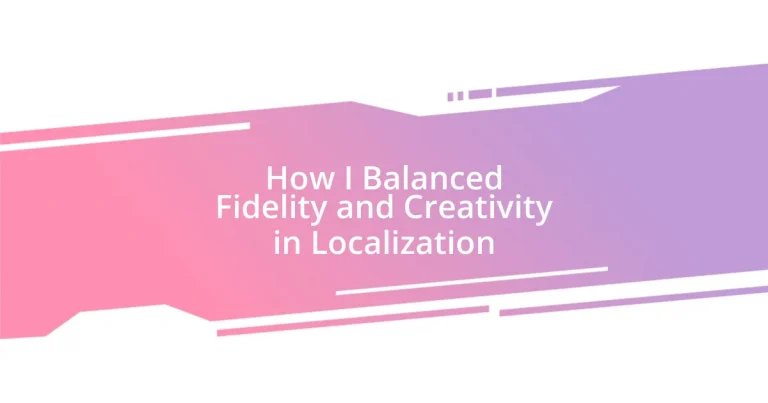Key takeaways:
- Localization goes beyond translation; it requires understanding cultural nuances and maintaining emotional resonance to engage different audiences effectively.
- Balancing fidelity and creativity is crucial in localization to ensure brand authenticity while adapting content for local tastes and preferences.
- Utilizing collaboration tools and testing strategies enhances the localization process, fostering creativity and ensuring the content connects meaningfully with users.

Understanding Localization Challenges
Localization isn’t just about translating words; it’s about conveying meaning and emotion. I recall a project where we worked with a client aiming to launch their app in Japan. We quickly discovered that nuances in language, like honorifics and cultural context, could drastically change user perception. Have you ever found yourself in a situation where a simple translation fell flat because of cultural differences? That’s a common challenge in the localization process.
Another challenge I often face revolves around maintaining brand voice while adapting to local tastes. I remember crafting a marketing campaign for a European brand that needed to resonate with both French and German audiences. It was a delicate balancing act—how do you keep the essence of the brand while ensuring the message feels familiar and engaging in different regions? This is where creativity and fidelity must intersect, and it’s not always easy.
Consistency in terminology can also pose hurdles. I once worked with a tech company that used specific jargon, and we found that what worked in one language caused confusion in another. This experience taught me the importance of not only translating words but also ensuring clarity in communication. How do we achieve coherence across diverse languages without losing the original intent? It’s a question that requires thoughtful consideration and, often, a bit of trial and error.

Importance of Fidelity in Localization
Fidelity in localization plays a crucial role in ensuring that the original message resonates with the target audience. I once worked on a video game localization project where the dialogue was not only a means of communication but also a vehicle for emotional connection. Striking the right balance in tone and context can shape a player’s experience, turning a standard narrative into something that feels deeply personal and immersive.
A memorable instance was when I had to localize a heartfelt story in a mobile app aimed at young adults in Brazil. The original text contained cultural references that were significant in the U.S. but puzzling to the Brazilian audience. By staying true to the vibes and emotions of the original content while adapting those references, we created a version that felt authentic and relatable, even leading to positive user feedback about how it made them feel understood.
The ripple effects of fidelity extend beyond words; they influence user trust and brand loyalty. A client I collaborated with found that maintaining fidelity cultivated a strong connection with their Italian user base, leading to increased engagement. When consumers feel that a brand respects their language and culture, it fosters a sense of belonging, creating a bond that goes beyond mere transactions.
| Aspect | Description |
|---|---|
| Emotional Resonance | Aligning the emotional tone of the original with local expectations enhances user engagement. |
| Cultural Relevance | Adapting cultural references ensures the message is understood and felt by the target audience. |
| User Trust | Fidelity reinforces brand authenticity, positively impacting user loyalty and retention. |

Nurturing Creativity in Localization
Nurturing creativity in localization is essential to breathe life into the translated content. I often find that allowing team members the freedom to explore ideas leads to unexpected and joyful results. For instance, during a localization project for an educational platform, I encouraged our translators to propose creative alternatives when they felt the literal translation might miss the mark. The result? A learning experience that resonated deeply with students and sparked lively discussions.
To foster creativity, consider these approaches:
- Collaborative Brainstorming: Gather diverse perspectives to inspire innovative solutions.
- Encourage Experimentation: Allow team members to test out unconventional ideas without the fear of failure.
- Celebrate Local Insights: Highlight and reward culturally relevant contributions that reshape the story in local contexts.
- Provide Resources: Equip your team with tools and references that spark imagination and cultural awareness.
By nurturing creativity thoughtfully, we can transform localization from a task into an art form.

Finding the Right Balance
Finding the right balance between fidelity and creativity in localization is like walking a tightrope. I remember a time when I worked on a marketing campaign for a fashion brand. The original tagline was clever but lost its charm in translation. By adjusting the wording to fit local slang while keeping the core message intact, we created an impactful statement that felt fresh and engaging to the audience. It was exhilarating to see how a small tweak could lead to a significant emotional connection with our users.
I often ask myself: what does true balance look like? In my experience, it’s about understanding the needs and preferences of the target audience while remaining aligned with the original intent. For example, in a localization project for a children’s book, I chose to maintain the playful spirit of the story, even if it meant altering some of the cultural references. I believe that seeing a child light up with understanding and joy reflects that perfect harmony.
Striking this balance can sometimes feel like a dance — fluid and dynamic. I’ve found that open communication with my team is vital. During one project, we held frequent discussions to weigh the importance of certain phrases and the cultural significance behind them. This collaborative effort not only enriched the translation process but also made everyone feel invested in the outcome. Moments like these remind me that balancing fidelity and creativity isn’t merely a task; it’s an opportunity for growth and connection.

Strategies for Creative Fidelity
Creative fidelity is about preserving the essence of the original content while allowing the creativity of the localization process to shine through. I remember a project where we translated a well-known video game. Instead of sticking to rigid translations, we adapted dialogues to include culturally relevant humor that locals would appreciate. The moment we presented the new version, it was clear how much more relatable the characters felt, making players feel that the game was truly made for them. Isn’t it exciting to think about how creative approaches can revive something familiar?
One effective strategy is to encourage your team to channel their own experiences and cultural backgrounds into the localization work. When I worked on localizing a culinary app, I encouraged team members to share their favorite regional dishes and anecdotes related to cooking. This not only infused the content with authenticity but also brought a sense of personal touch that really resonated with the users. How often do we overlook the richness of local narratives that can elevate our messaging?
Another approach I highly recommend is to prototype and test creative variations before finalizing any translation. During a campaign for a beauty brand, we had several iterations of an ad that played with bold colors and bold phrases. We ran focus groups to gauge reactions and gather feedback, which led us to a version that combined both fidelity to the brand’s voice and a fresh take on local preferences. It reinforced the idea that creativity thrives on collaboration and experimentation—do you remember a time when you discovered that taking a risk paid off in unexpected ways?

Tools for Effective Localization
In my journey through localization, I’ve encountered a plethora of tools that can significantly enhance the effectiveness of our efforts. One standout is translation management software, which streamlines the entire process by coordinating various language teams simultaneously. I recall a specific project where this tool saved us a week’s worth of work, allowing us to focus on refining the nuances rather than getting bogged down in logistics. Isn’t it remarkable how technology can free up our creative spark?
Collaboration platforms have also proven invaluable. Tools like Slack or Microsoft Teams facilitate ongoing conversations among team members, breaking down barriers that can sometimes stifle creativity. For example, while localizing an educational app, our team used these platforms to share spontaneous ideas and quick translations throughout the day. This real-time feedback sparked innovative solutions that wouldn’t have arisen in a more isolated environment. Have you ever experienced a moment where casual discussions led to a brilliant breakthrough?
Lastly, investing in quality localization testing tools is paramount. I once worked on a project for a travel website, and during our testing phase, we discovered that certain phrases didn’t translate well and could be misunderstood. By utilizing A/B testing strategies, we were able to confirm which localized phrases resonated better with users before launch. It taught me that insights gathered through testing can often illuminate the path to deeper connections with audiences. Have you found that to be true in your experience?

Measuring Success in Localization
To truly measure success in localization, I often reflect on user engagement metrics and feedback. For instance, when I localized a popular streaming service, I focused on viewer retention rates per region after the launch. The way audiences responded through their viewing habits revealed the depth of connection they felt to the localized content—it felt rewarding to see increased subscriptions following our tailored approach. Doesn’t it feel fulfilling to witness your efforts resonate so deeply?
Another crucial metric is the direct feedback from users themselves. While working on a book translation project, I organized online surveys to capture readers’ sentiments about the localization choices we made. The glowing responses were more than just numbers; they were stories of how readers found themselves reflected in the characters and settings. Isn’t it enriching to know that your work can foster such emotional connections?
Finally, I’ve found that tracking brand sentiment across social media platforms plays a key role in gauging success. In a recent campaign for a fashion retailer, I kept a close eye on comments and shares following the launch of localized ads. The surge in positive feedback showcased how well our creative adaptations resonated with the target audience. Have you ever felt that thrill when your audience imbues your work with their admiration, just like I did?














